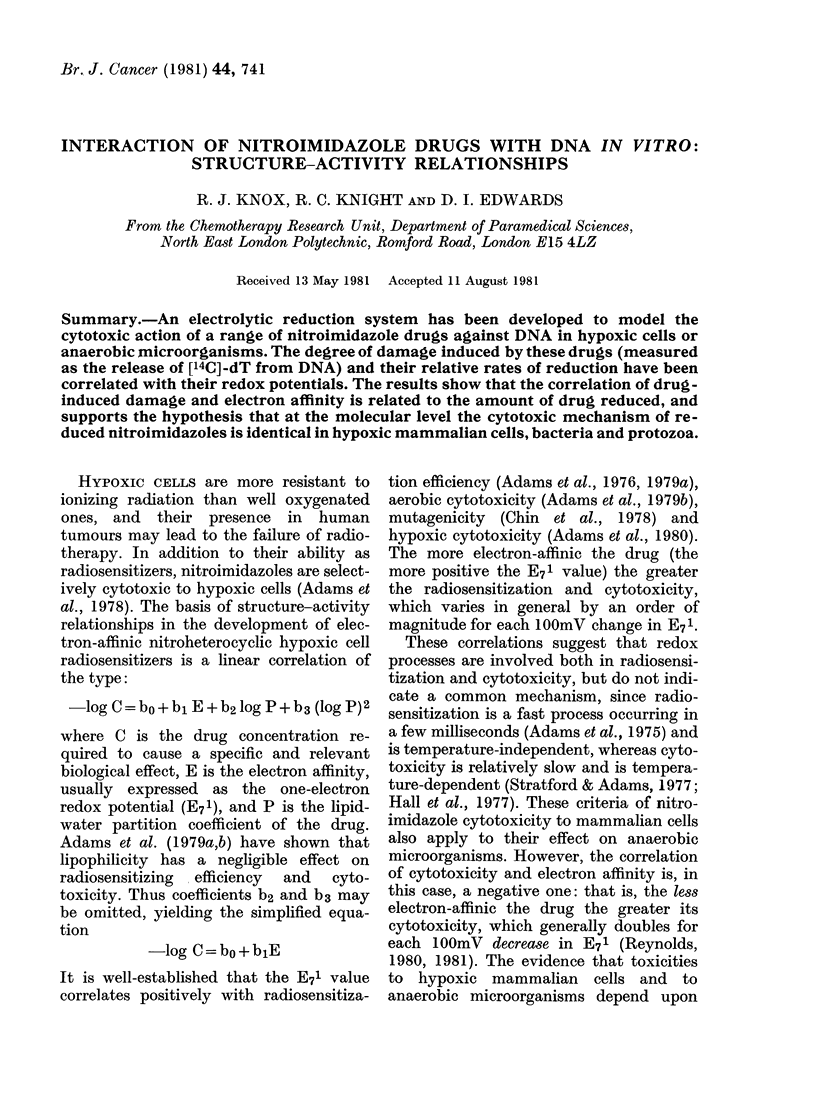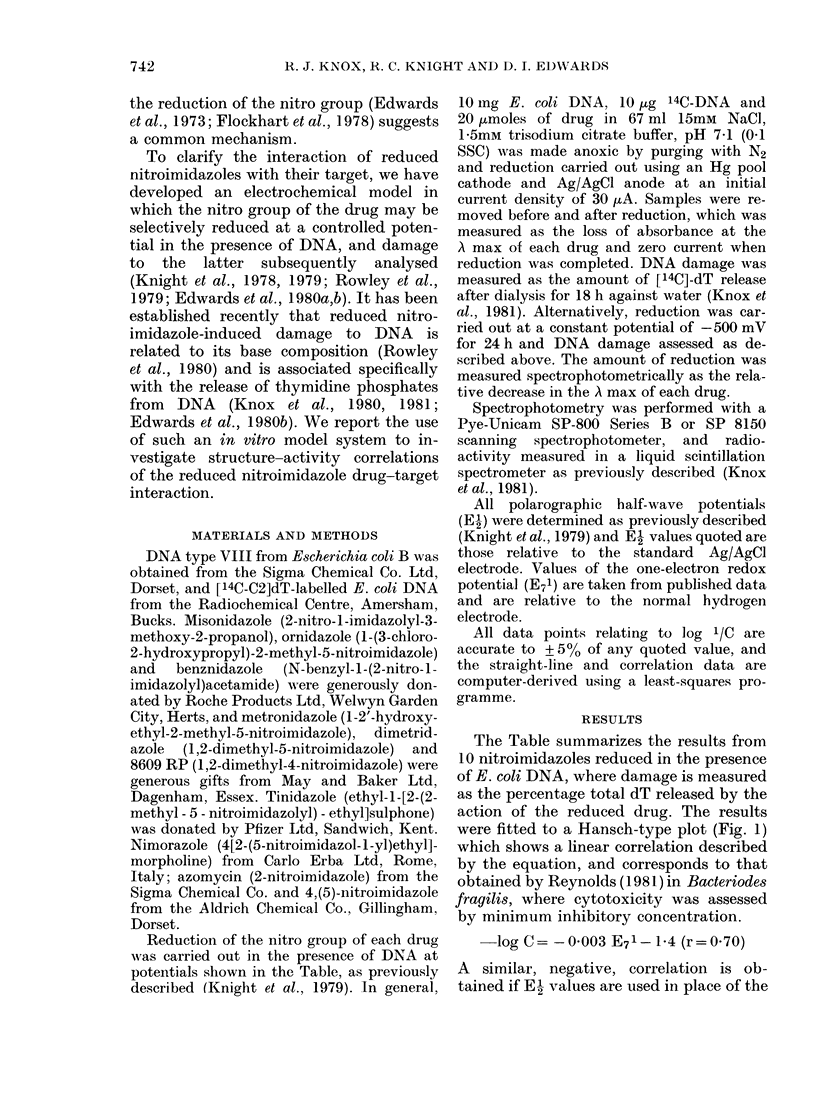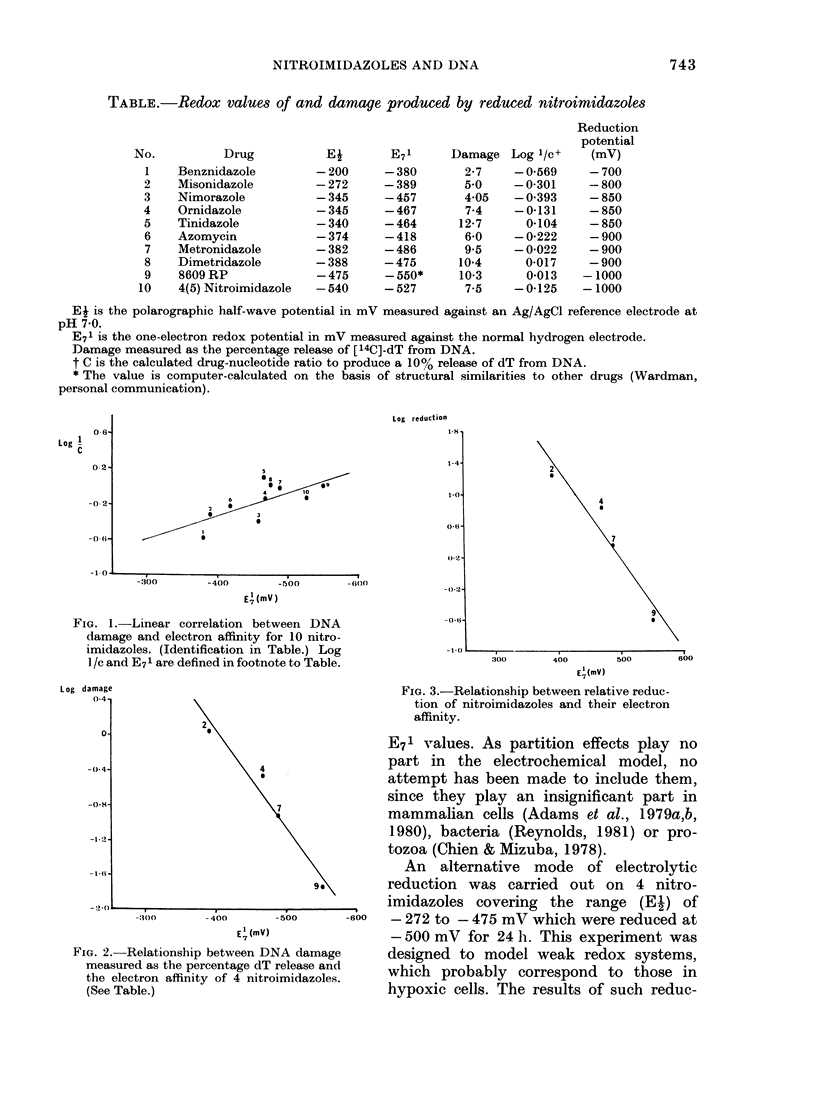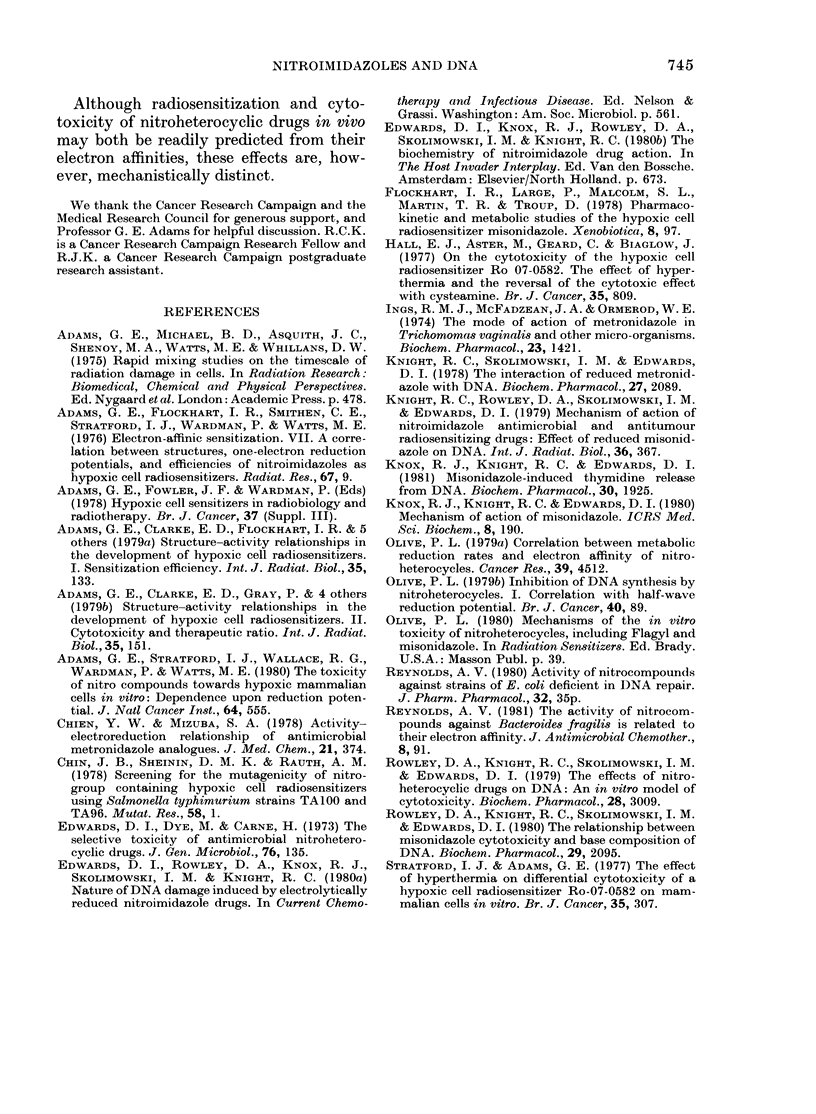Abstract
An electrolytic reduction system has been developed to model the cytotoxic action of a range of nitroimidazole drugs against DNA hypoxic cells or anaerobic microorganisms. THe degree of damage induced by these drugs (measured as the release of [14C]-dT from DNA) and their relative rates of reduction have been correlated with their redox potentials. The results show that the correlation of drug-induced damage and electron affinity is related to the amount of drug reduced, and supports the hypothesis that at the molecular level the cytotoxic mechanism of reduced nitroimidazoles is identical in hypoxic mammalian cells, bacteria and protozoa.
Full text
PDF




Selected References
These references are in PubMed. This may not be the complete list of references from this article.
- Adams G. E., Clarke E. D., Flockhart I. R., Jacobs R. S., Sehmi D. S., Stratford I. J., Wardman P., Watts M. E., Parrick J., Wallace R. G. Structure-activity relationships in the development of hypoxic cell radiosensitizers. I. Sensitization efficiency. Int J Radiat Biol Relat Stud Phys Chem Med. 1979 Feb;35(2):133–150. doi: 10.1080/09553007914550151. [DOI] [PubMed] [Google Scholar]
- Adams G. E., Clarke E. D., Gray P., Jacobs R. S., Stratford I. J., Wardman P., Watts M. E., Parrick J., Wallace R. G., Smithen C. E. Structure-activity relationships in the development of hypoxic cell radiosensitizers. II. Cytotoxicity and therapeutic ratio. Int J Radiat Biol Relat Stud Phys Chem Med. 1979 Feb;35(2):151–160. doi: 10.1080/09553007914550161. [DOI] [PubMed] [Google Scholar]
- Adams G. E., Flockhart I. R., Smithen C. E., Stratford I. J., Wardman P., Watts M. E. Electron-affinic sensitization. VII. A correlation between structures, one-electron reduction potentials, and efficiencies of nitroimidazoles as hypoxic cell radiosensitizers. Radiat Res. 1976 Jul;67(1):9–20. [PubMed] [Google Scholar]
- Adams G. E., Stratford I. J., Wallace R. G., Wardman P., Watts M. E. Toxicity of nitro compounds toward hypoxic mammalian cells in vitro: dependence on reduction potential. J Natl Cancer Inst. 1980 Mar;64(3):555–560. [PubMed] [Google Scholar]
- Chien Y. W., Mizuba S. S. Activity-electroreduction relationship of antimicrobial metronidazole analogues. J Med Chem. 1978 Apr;21(4):374–380. doi: 10.1021/jm00202a012. [DOI] [PubMed] [Google Scholar]
- Chin J. B., Sheinin D. M., Rauth A. M. Screening for the mutagenicity of nitro-group containing hypoxic cell radiosensitizers using Salmonella typhimurium strains TA 100 and TA98. Mutat Res. 1978 Sep;58(1):1–10. [PubMed] [Google Scholar]
- Edwards D. I., Dye M., Carne H. The selective toxicity of antimicrobial nitroheterocyclic drugs. J Gen Microbiol. 1973 May;76(1):135–145. doi: 10.1099/00221287-76-1-135. [DOI] [PubMed] [Google Scholar]
- Flockhart I. R., Large P., Troup D., Malcolm S. L., Marten T. R. Pharmacokinetic and metabolic studies of the hypoxic cell radiosensitizer misonidazole. Xenobiotica. 1978 Feb;8(2):97–105. doi: 10.3109/00498257809060388. [DOI] [PubMed] [Google Scholar]
- Hall E. J., Astor M., Geard C., Biaglow J. Cytotoxicity of Ro-07-0582; enhancement by hyperthermia and protection by cysteamine. Br J Cancer. 1977 Jun;35(6):809–815. doi: 10.1038/bjc.1977.122. [DOI] [PMC free article] [PubMed] [Google Scholar]
- Ings R. M., McFadzean J. A., Ormerod W. E. The mode of action of metronidazole in Trichomonas vaginalis and other micro-organisms. Biochem Pharmacol. 1974 May 1;23(9):1421–1429. doi: 10.1016/0006-2952(74)90362-1. [DOI] [PubMed] [Google Scholar]
- Knight R. C., Rowley D. A., Skolimowski I., Edwards D. I. Mechanism of action of nitroimidazole antimicrobial and antitumour radiosensitizing drugs. Effects of reduced misonidazole on DNA. Int J Radiat Biol Relat Stud Phys Chem Med. 1979 Oct;36(4):367–377. doi: 10.1080/09553007914551151. [DOI] [PubMed] [Google Scholar]
- Knight R. C., Skolimowski I. M., Edwards D. I. The interaction of reduced metronidazole with DNA. Biochem Pharmacol. 1978;27(17):2089–2093. doi: 10.1016/0006-2952(78)90277-0. [DOI] [PubMed] [Google Scholar]
- Knox R. J., Knight R. C., Edwards D. I. Misonidazole-induced thymidine release from DNA. Biochem Pharmacol. 1981 Jul 15;30(14):1925–1929. doi: 10.1016/0006-2952(81)90201-x. [DOI] [PubMed] [Google Scholar]
- Olive P. L. Correlation between metabolic reduction rates and electron affinity of nitroheterocycles. Cancer Res. 1979 Nov;39(11):4512–4515. [PubMed] [Google Scholar]
- Olive P. L. Inhibition of DNA synthesis by nitroheterocycles. I. Correlation with half-wave reduction potential. Br J Cancer. 1979 Jul;40(1):89–93. doi: 10.1038/bjc.1979.144. [DOI] [PMC free article] [PubMed] [Google Scholar]
- Reynolds A. V. The activity of nitro-compounds against Bacteroides fragilis is related to their electron affinity. J Antimicrob Chemother. 1981 Aug;8(2):91–99. doi: 10.1093/jac/8.2.91. [DOI] [PubMed] [Google Scholar]
- Rowley D. A., Knight R. C., Skolimowski I. M., Edwards D. I. The effect of nitroheterocyclic drugs on DNA: an in vitro model of cytotoxicity. Biochem Pharmacol. 1979 Oct 1;28(19):3009–3013. doi: 10.1016/0006-2952(79)90601-4. [DOI] [PubMed] [Google Scholar]
- Rowley D. A., Knight R. C., Skolimowski I. M., Edwards D. I. The relationship between misonidazole cytotoxicity and base composition of DNA. Biochem Pharmacol. 1980 Aug 1;29(15):2095–2098. doi: 10.1016/0006-2952(80)90178-1. [DOI] [PubMed] [Google Scholar]
- Stratford I. J., Adams G. E. Effect of hyperthermia on differential cytotoxicity of a hypoxic cell radiosensitizer, Ro-07-0582, on mammalian cells in vitro. Br J Cancer. 1977 Mar;35(3):307–313. doi: 10.1038/bjc.1977.44. [DOI] [PMC free article] [PubMed] [Google Scholar]


